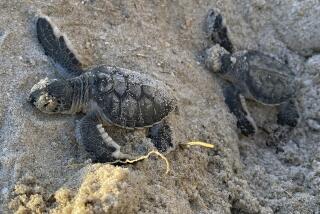Endangered Sea Turtles Facing Array of Enemies : Sri Lanka: Tourists and environmentalists join natural predators and poachers on list of threats to dwindling population.
- Share via
BENTOTA, Sri Lanka — Like many endangered species, sea turtles face threats ranging from natural predators to poachers. But they may be the only animal whose list of common enemies includes would-be environmentalists and friendly tourists.
To save the nation’s dwindling population of marine turtles, conservationists began in 1979 to build sanctuaries near Sri Lankan beaches. They buy turtle eggs from poachers, hatch them and guard the newborns as they crawl into the Indian Ocean.
Today some of those hatcheries are doing more harm than good, according to the Turtle Conservation Project, an environmental group based in England that is working in Sri Lanka.
To become moneymaking tourist attractions, the hatcheries cram hundreds of baby turtles into small cement tanks of salt water and risk their lives by holding them there for days.
The turtles swim in circles, wasting the energy they will need to swim two or three days to safety once they enter the ocean.
At Kosgoda sanctuary in Bentota, children can be seen lifting baby turtles out of the tanks and playing with them unsupervised.
At other hatcheries, adults pay money to release baby turtles on beaches during the day and watch them run for the ocean. The tourists leave feeling like noble environmentalists, not knowing that turtles usually are born at night so they have a better chance of swimming away without being eaten.
Of the 16 hatcheries operating, the Turtle Conservation Project believes that more than half of them are doing more harm than good.
“We’re trying to persuade the government to promote the few good hatcheries and close down the very bad ones,” Peter Richardson, a project director, said in an interview.
But that could be difficult in a nation where many people profit from poaching and the government does little to stop them.
Five of the world’s seven sea turtle species nest on the shores of southwestern Sri Lanka, a tear-shaped island south of India. For centuries, Sri Lankans have captured the green turtles, leatherbacks, hawksbills, loggerheads and olive ridleys, and used their shells, meat, leather skin and eggs for everything from turtle soup, steak and omelets to hair bands and bangles.
Male turtles--which stay at sea, grow as large as six feet and weigh up to 220 pounds--are killed by fishermen more often than by sharks and barracudas.
Female turtles and their babies are even more vulnerable. Poachers often capture and kill the mothers as they lay hundreds of eggs on beaches at night.
Some people eat the eggs for their protein or purported medicinal value. But most sell them to the hatcheries, local markets or taverns that serve them hard-boiled.
Eggs that manage to remain in the sand hatch turtles about two inches long.
As they crawl toward the ocean, they must avoid crabs, poachers, stray dogs and other predators. As they swim out to sea, they are threatened by creatures ranging from sea gulls to sharks.
Richardson estimates that only about 1 in 1,000 baby turtles that reach the Indian Ocean survive.
Twenty-three years ago, the Sri Lankan government banned the capture and sale of turtles and turtle products in an effort to save the endangered species. But it has done little to enforce the laws, which are widely ignored.
Many of the shops and hotels that cater to the tourists who visit this tropical island from Europe, the United States and Japan sell tortoise-shell combs, hair bands and jewelry boxes.
Even the turtle sanctuaries are technically breaking the law by purchasing eggs from poachers.
Nevertheless, Suhashini Hewavisenthi, a zoologist at Colombo University, says they must be preserved. “There is no option at this moment other than the hatcheries. If not, the eggs will end up in someone’s stomach,” he said in an interview.
Richardson agrees, as long as they are improved.
“For years nearly 100% of Sri Lanka’s turtle nests have been robbed of their eggs. In the next 10 years there could be a massive population crash,” he said. “To prevent that we hope to educate Sri Lankans and improve the hatcheries.”
If that fails, sea turtles could become extinct in Sri Lanka.
More to Read
Sign up for Essential California
The most important California stories and recommendations in your inbox every morning.
You may occasionally receive promotional content from the Los Angeles Times.













